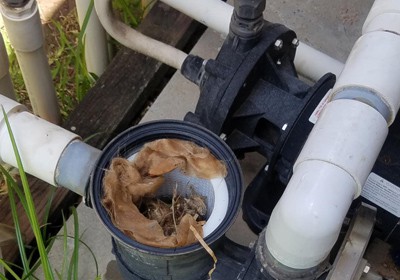Steam cleaning is an effective method for mold removal, using high-temperature steam to kill mold spores. This process can help sanitize surfaces without harsh chemicals.
Must-Have Cleaning Essentials For Every Home (Recommended):

- Consistently delivers the same smell, color, and results - every time. For superior and safer cleaning performance, in and around your home.

- Great household product for anything that needs a bright new look! Use it as a cleansing booster with your laundry or dish detergent, as a pH buffer in swimming pools, or for cleaning kitchen surfaces.
Mold poses serious health risks and maintaining a clean home environment is crucial for wellbeing. Steam clean mold eradication offers a chemical-free and eco-friendly solution to this problem. Utilizing the power of steam, which reaches temperatures high enough to kill mold and bacteria, this cleaning method is both potent and safe for various surfaces.
It not only addresses visible mold but also penetrates porous materials to eliminate mold at its roots, preventing regrowth. Suitable for bathrooms, kitchens, and other mold-prone areas, steam cleaning can help maintain a healthy living space. With the combination of high heat and moisture, a thorough steam clean disinfects while it refreshes, making it an essential tool in the fight against mold.
Introduction To Mold Issues
Mold poses real challenges in homes and workplaces. This sneaky intruder can creep into damp spaces and multiply quickly. Often, it remains unseen until it becomes a serious issue. Mold isn’t just unsightly; it affects air quality and health.
Understanding Mold And Its Risks
Mold is a type of fungus that spreads through spores in the air. Once it lands on moist surfaces, it starts to grow. Exposure to mold can lead to allergies, respiratory problems, and other health concerns. It’s crucial to identify and address mold issues promptly.
Common Areas Where Mold Thrives
Certain places offer perfect conditions for mold growth. These include bathrooms, basements, and kitchens where humidity levels are higher. Keep an eye on these spots:
- Shower corners and curtains
- Window sills
- Under sinks
- Laundry rooms
Why Steam Cleaning Is An Effective Solution
Steam cleaning kills mold and prevents its return. The hot steam penetrates surfaces, reaching mold at its roots. Steam effectively sanitizes without toxic chemicals, making it a safe choice for homes and the environment. Additionally, steam evaporates, leaving behind less moisture to foster new mold growth.

Credit: www.amazon.com
Steam Cleaning Fundamentals
Steam cleaning is a powerful way to clean surfaces. High temperatures from steam can remove dirt, grease, and mold. This method uses steam vapor to penetrate tiny pores on surfaces. It kills mold spores without harsh chemicals. Let’s dive into the details of how steam cleaning works.
The Science Behind Steam Cleaning
Steam cleaning involves heating water to create vapor. The steam’s heat sanitizes surfaces and loosens dirt. It’s effective against mold because of the high temperatures. The dry vapor steam also has low moisture, which prevents mold growth.
Pros And Cons Of Steam Cleaning For Mold
- Pros:
- No harsh chemicals
- Kills mold and spores
- Safe for various surfaces
- Eco-friendly
- Cons:
- Not for all surfaces
- Can be pricey
- Needs electricity
- Requires proper handling
Different Types Of Steam Cleaners
| Type | Best For | Features |
|---|---|---|
| Handheld Steamers | Small areas | Portable, easy-to-use |
| Cylinder Steamers | Large homes | Powerful, large tanks |
| Vapor Steamers | Killing mold | High temperature, dry vapor |
Step-by-step Mold Removal With Steam Cleaning
A spotless, healthy home is a happy home, and steam cleaning is a powerful ally in the battle against mold. Mold can be a nuisance and a health hazard. But worry not, as steam cleaning provides an eco-friendly and effective solution. Let’s guide you through a thorough steam cleaning mold removal process.
Preparation Before Steam Cleaning
Before starting, proper preparation ensures a safe and efficient mold removal:
- Identify all the affected areas.
- Clear the area of furniture and other items.
- Wear protective gear like gloves and masks.
- Seal off the space to prevent mold spores from spreading.
- Ensure good ventilation to the room.
The Steam Cleaning Process
Steam cleaning mold involves a few key steps:
- Fill your steam cleaner with distilled water to prevent scaling.
- Heat the steam cleaner to the highest temperature.
- Pass the steam cleaner slowly over the moldy areas.
- Do not over-saturate the surfaces.
- Attach a nozzle or brush for tough mold spots.
- Use short bursts of steam for deep cleaning.
Tip: Keep the steamer moving to avoid damage to your surfaces.
Post Steam Cleaning Tips And Maintenance
After steam cleaning, take the following steps for best results:
- Dry all surfaces thoroughly to prevent new mold growth.
- Clean your steam cleaner after use.
- Monitor treated areas regularly for any sign of mold return.
For ongoing prevention, maintain a dry, well-ventilated environment and consider a dehumidifier use in high moisture areas.

Credit: www.fortador-usa.com
Safety And Prevention
Ensuring safety during steam cleaning is crucial, especially when tackling mold. Protective measures help avoid health risks. After cleaning, knowing how to keep mold away is vital. Sometimes, a mold issue is too big to handle alone. Knowing when to call in the experts can save time, health, and money.
Safety Measures During Steam Cleaning
Steam cleaning mold demands caution. Safety gear is non-negotiable. Wear gloves, goggles, and a mask to prevent mold spores from causing harm. Keep the room well-ventilated to disperse heat and humidity.
- Use protective gear: gloves, goggles, and masks.
- Ensure room ventilation.
- Keep children and pets away during cleaning.
- Follow the steam cleaner’s manual keenly.
How To Prevent Mold Growth Post-cleaning
After steam cleaning, take steps to keep mold at bay. Maintain low humidity levels and keep areas dry. Fix leaks and improve airflow. Use mold-resistant products where possible. Regularly check and clean to catch mold before it spreads.
- Maintain humidity below 50%.
- Fix leaks promptly.
- Ensure good airflow in rooms.
- Use mold-resistant materials and paint.
- Clean regularly to prevent spore accumulation.
When To Call A Professional
If the mold infestation is large, or if you have health concerns, seek professional help. They can safely remediate the area. Professionals also offer long-term solutions. Look for certified mold remediation experts.
- Mold covers extensive areas?
- Health risks like allergies or asthma present?
- Lack the right equipment?
Call a professional. They assess the situation and suggest the best course of action.
Understanding Mold Issues
Mold in homes can be a silent menace, impacting health and property. Knowing about the common types and their implications is crucial for tackling the issue effectively. Misconceptions about mold can lead to improper handling. It’s time to clarify and combat mold with precision.
The Types Of Molds And Their Implications
Not all molds are identical. Each type has unique characteristics and risks:
- Aspergillus: Often found in homes, can cause allergic reactions.
- Cladosporium: Grows at cool temperatures, can trigger breathing problems.
- Black Mold (Stachybotrys): Dangerous, linked to severe health issues.
Here’s a breakdown of mold categories and their implications:
| Mold Type | Location | Health Risks |
|---|---|---|
| Allergenic | Windows, damp areas | Itchy eyes, sneezing |
| Pathogenic | Bathrooms, kitchens | Respiratory conditions |
| Toxigenic | Basements, ceilings | Serious health issues |
Understanding these types helps in choosing the right cleaning method.
Common Misconceptions About Mold
Myths about mold can cause needless worry or underestimation of its impact:
- “Bleach Kills All Mold”: Not true for porous surfaces where mold roots deeply.
- “Mold Is Only Black”: Mold comes in various colors, including green and white.
- “A Dry Surface Can’t Have Mold”: Mold spores can linger and wait for moisture to regrow.
Clearing up these misconceptions goes a long way in handling mold correctly and maintaining a clean, healthy environment.

Credit: www.amazon.com
Case Studies And Testimonials
‘Steam Clean Mold 101’ has transformed countless homes from mold havens into healthy living spaces. The effectiveness of steam cleaning in mold remediation is highlighted through our case studies and testimonials. Real-life examples showcase the power of high-temperature steam in tackling the stubbornness of mold.
Success Stories In Mold Remediation
Our clients’ victories over mold are nothing short of inspiring. Hear from those who’ve reclaimed their homes:
- Jane’s bathroom makeover: Mold’s grip on her tiles was released with just a few steam sessions.
- Mike’s basement revival: Chronic dampness and mold were banished, making the basement inviting again.
- Lisa’s kitchen triumph: The fridge area was always a trouble zone, now it’s mold-free and fresh.
Challenges And How To Overcome Them
However, the path to a mold-free home isn’t always a straight line. Obstacles are common but surmountable:
| Challenge | Solution |
|---|---|
| Hard-to-reach mold | Attachments and accessories bring steam to every nook. |
| Persistent mildew smell | Regular steam treatments deodorize effectively. |
| Mold recurrence | Maintenance sessions prevent future growth. |
Patience and consistency are your best allies in these scenarios.
Frequently Asked Questions For Steam Clean Mold 101
Will Steam Cleaning Remove Mold?
Steam cleaning can effectively remove surface mold. It uses high-temperature steam to kill mold spores and remove mold from various surfaces. However, it may not eliminate mold embedded deep inside porous materials. Regular maintenance is recommended to prevent mold regrowth.
What Should You Not Steam Clean?
Avoid steam cleaning delicate fabrics, untreated wood, musical instruments, and electrical items. Be cautious with items that can warp, melt, or discolor from heat and moisture.
What Do You Spray Before Steam Cleaning?
Before steam cleaning, spray a pre-treatment solution on stains and high-traffic areas to break down dirt and grime, ensuring a deeper clean.
What Are The Disadvantages Of Steam Cleaning?
Steam cleaning can damage heat-sensitive materials, cause mold if areas remain damp, and may not effectively remove all stains. It requires lengthy drying times and frequent refilling during large jobs.
Conclusion
Steam cleaning molds off surfaces is a powerful option. This method not only deep cleans but also disinfects, offering peace of mind. Regular maintenance can prevent mold resurgence. For safety and effectiveness, follow proper techniques. Embrace steam cleaning for a mold-free, healthier living space.




